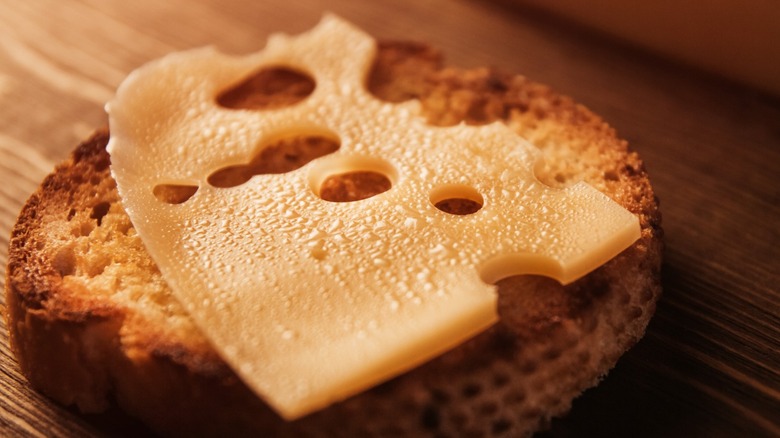The Science Behind Why Your Cheese Is Sweating And If It's Safe To Eat
It's the moment any cheese lover dreads most: You've put together the ultimate cheese board. But just as you or one of your guests reaches for a bit of Gouda or Manchego, you see that little bubbles of sweat have formed on its once perfect, smooth surface. Why is this happening? Is the cheese no longer safe to eat? There are two reasons your cheese might produce some of this moisture, or "sweat." One has to do with the fatty acids in cheese.
Cheese is made from milk that has been coagulated and has had lactic acid-producing bacteria added to it for fermentation. Curds and whey form, and the curds are then separated and pressed into molds. The resulting cheese consists of protein, fat, water, and sugars, plus fatty acids. The proteins are specifically a sort found in milk and dairy known as casein proteins. These casein proteins loosen up if cheese starts reaching room temperature, and that causes them to release those fatty acids. The acids then rise to the surface of the cheese as little drops of oil.
Another source of cheese sweat is simple condensation. Cheese is often sold wrapped in plastic. As the cheese sits around, whether that's on your counter or in your refrigerator, it starts releasing water vapor. Sweaty cheese is totally safe to eat, as the sweat is just some of the cheese's oils or water. But it doesn't look appetizing, and it's indeed not the best condition to enjoy the cheese in.
How to avoid sweaty cheese
While sweaty cheese is safe, it's not what you want. Consider the first cause of the sweating, fatty acids. Fats give different cheeses their textures and flavors — the more fats, the softer the cheese is, and often the more flavorful, too. If those acids are leaving the cheese because it's warming up, they're taking their soft texture and rich flavors with them. Looking at the second cause, condensation, these cheeses are safe to enjoy immediately, but that water vapor is moisture that will eventually start inviting in bacteria and mold, leading to unsafe spoilage.
Higher-fat cheeses are more likely to sweat — and if you know many types of cheese, you know that this includes varieties like cheddar and Swiss. Plus, any type is prone to sweating in warmer temperatures, which is why you usually see sweaty cheeses on platters that have been sitting around for a while. To keep your cheese from sweating in the longer term, follow these tips for storing cheese and keeping it fresh. In particular, remove it from plastic and wrap it in greased paper or aluminum foil instead.
This allows moisture to escape instead of turning into condensation. You can even put a sugar cube in an airtight container with your cheese, because the sugar will absorb the moisture. Importantly, never let cheese hang out at too warm of temperatures. This goes for serving, too: To prevent sweaty cheeses on your platter, take out only what you need from the fridge, as close to when it will be enjoyed as possible.

